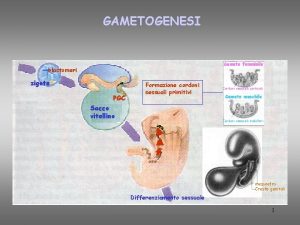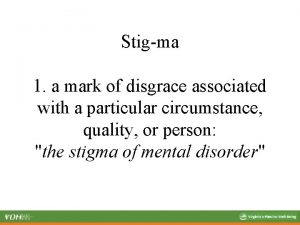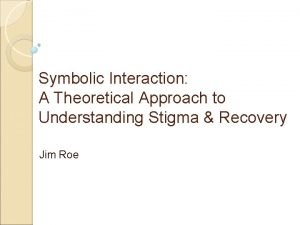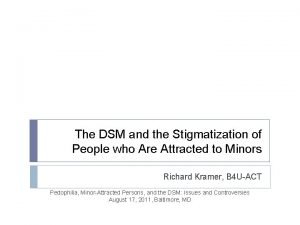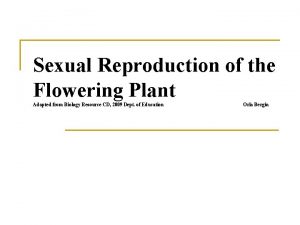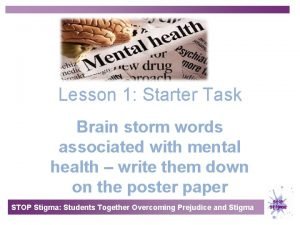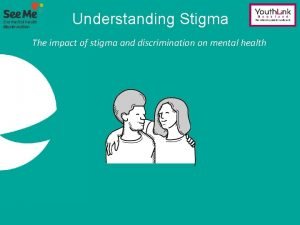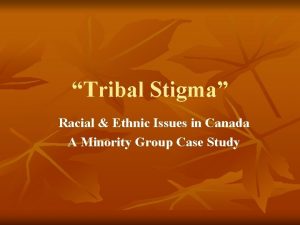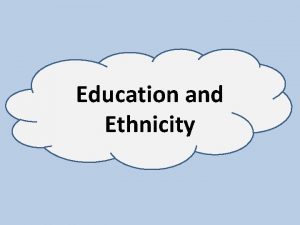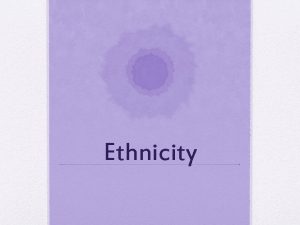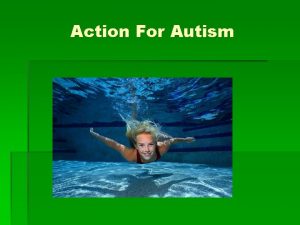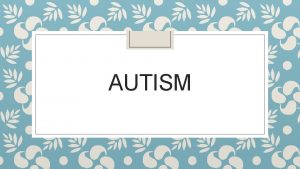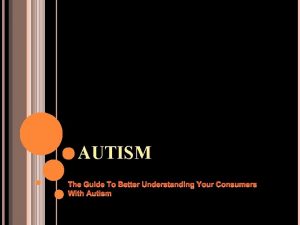Autism stigma and its links with ethnicity and















- Slides: 15

Autism stigma and its links with ethnicity and culture Dr Chris Papadopoulos University of Bedfordshire

What is stigma? • The term ‘stigma’ originally comes from the Greek word ‘stig’ which means “a mark, dot, puncture”. Ancient Greeks used it to highlight slaves or anyone of inferior social status. • This meaning carries on today; when someone is ‘stigmatised’ it means we have been marked or labelled as inferior and different (in a negative way). When the public stigmatise people we call this ‘social stigma’ or ‘public stigma’

Should we care? • Yes, because of the consequences…e. g: ØFormation of stereotypes/negative beliefs ØNegative emotional responses ØBehavioural discrimination ØPoor mental health and wellbeing q. Also affects family carers/parents (Papadopoulos et al, 2018). ØSelf-stigma and the ‘why try’ effect

Is stigma a problem for autistic people and their families? • Online community listening exercise over 6 months: • 198 people (n=147 family carers) responded • 164/198 (82. 8%) respondents claimed to have experienced public stigma • 134/184 respondents (72. 8%) reported having experienced courtesy stigma or self-stigma • Note: ‘Courtesy stigma’ = stigma from society that is directed specifically towards the carer e. g. the belief that carer should be ashamed or blamed for their child being autistic (Milacic-Vildojevic et al, 2012)

Few examples: § “Since having my autistic daughter, I have often been ignored by people and friends, and not included. This has made me feel hurt as I feel very lonely, and also I feel hurt on my daughter's behalf that people have made judgements about us. Luckily my daughter is oblivious but I have often felt hurt and down” § “My sister once told me that since my son was diagnosed with autism she wouldn't ever have another baby incase she ended up like me and her child ended up like mine” § “I was once told by a passer by that I should buy a gag for my daughter who had become distressed during a meltdown while shopping and that a good mother would be able to stop her from crying - I felt devastated”

Does culture and ethnicity play a role? • Let’s look at some of the (inter-linked) reasons why it very likely does:

Reason 1: Knowledge about autism • Poor knowledge about a phenomenon increases risk of stigma. • E. g. Obeid et al (2015) sampled University students in the US (n=346) and Lebanon (n=329). • They found that both groups held stigma but US students had higher knowledge and lower stigma compared to Lebanese students • Interestingly, both groups had many misconceptions that were group specific e. g. the Lebanese students were much more likely to believe • that autistic individuals lack interest in social interaction • are deliberately uncooperative, • that autism is caused by negative parenting, • Whereas the US students more frequently believed that: • all autistic people have learning difficulties • that socio-economic inequalities do not hamper access to services • Take home message: different cultural groups have different levels of understanding and knowledge meaning type and degree of stigma likely to vary across cultures.

Reason 2: Service provision • One key reason why knowledge is poorer in some communities is because there is less service provision (Grinker et al, 2011) • So we should expect that in cultures and communities where there is less available and accessible high quality service provision, higher rates of stigma will exist. • E. g. generally higher rates of misconceptions about autism in the Middle East and developing countries where services and resources are lower (e. g. Saudi Arabia: Alqahtani, 2012; Nepal: Kharti et al, 2011; Nigeria: Bakare et al, 2009; Pakistan: Imran et al, 2011) • This is likely to go both ways i. e. as stigma reduces in a community or nation, we should expect services to increase (policy shifts)

Reason 3: Collectivist cultures • ‘Collectivist cultures’ (value group interdependence) may be more likely than ‘individualist cultures’ (value personal independence) to stigmatise people who deviate from the norm. • This is partly because such people are more likely to be identified in the community due to high surveillance levels, which such cultures rely upon in achieving their goals of interdependence and group conformity (Papadopoulos et al, 2013). Members of collectivist communities know this and thus try to conceal or hide what they believe deviates from the normal • Dababnah & Parish’s (2013) qualitative study of Palestinian parents reported that “discrimination and stigma from extended family members and the larger community intensified parents' feelings of shame and experiences of social isolation” (p 1670) leading parents admitting to actively hiding their situation from others due to community surveillance • In Guler et al’s (2017) qualitative study of autism in South Africa, one parent states, “You … you know … it’s that our culture. He doesn’t want to come out of the box. So he (my uncle) said that this information (his child’s ASD) must stay as it is … a secret” (p 9)

Reason 4: Religion • There’s good evidence that higher levels of religious faith are linked with higher rates of mental illness stigma (e. g. Wisneski et al, 2009; Tzouvara & Papadopoulos 2014). • One likely reason for this is because higher religiosity tends to be found in communities where professional services are less available, inaccessible and/or are distrusted. • Nwokolo (2010) highlights that among Nigerian rural communities, where influence of religion is particularly great and so few professional services exist, it is common for families to turn to exorcism. • Alqahtani (2012) has shown how Saudi Arabian parents tend to rely on interventions involving religious healers, and attribute autism to the ‘evil eye’ which ascribes one’s misfortunes to ‘envy in the eye of the beholder’ • Guler et al’s (2017) study of autism in South Africa also reported cultural perceptions of an autistic child being cursed: “people will think that my child has been bewitched or … bad things happened in our house … maybe my aunt is not happy with me and she just cursed my child or cursed me or something. ” (p 5)

Reason 5: Health inequalities • We know ethnicity is a key determinant of health (and social) inequalities in England (and beyond) • This results in BAME communities being less likely to be able to access to autism services • This increases the risk of lower understanding, knowledge and awareness which in turn increases the likelihood of stigma manifesting. • If minority groups do access services but then experience poor cultural sensitivity and awareness from service providers, they may reject these services. • Services then lose the opportunity to engage with the community and boost understanding, and the risk of stigma remains.

So…what can we do? A few reasonable actions: 1. Make anti-stigma interventions culturally tailed: (a) Understand what is driving stigma within cultures. What are the specific misconceptions? This means more research and building of theoretical underpinning of stigma at the cultural level

Scoping review of autism stigma in African settings (Awosanya, Papadopoulos, Pappas 2018 – in progress) Authors Setting Approach Stigma examples Zeleke, Hughes & Chitiyo (2017) Ethiopia Quantitative survey (n=100 parents) Many parents said they used traditional and spiritual treatment (e. g. , using holy water, using herbs) Tekola et al (2016) Ethopia Qualitative (n=10 families) Stigma, exclusion and negative attitudes/judgments against children with autism and their families found as key issue Tilahun et al (2016) Ethopia Quantitative survey (n=102 caregivers) High levels of stigma experienced by caregivers. Many worried about being treated differently, felt ashamed and the need to hide child, worry that people would be reluctant to marry into their family, Gona et al (2015) Kenya Quantitative survey (n=103 parents) Majority experienced shame, social isolation of their child, community intolerance and problems negotiating public encounters Bakare et al (2009) Nigeria Quantitative survey (n=134 nurses) Many subscribed autism to supernatural and preternatural causes Paul & Gabriel-Brisibe (2015) Nigeria Quantitative survey (n=100 primary school teachers) Many subscribed autism as a spiritual affliction and similar to madness, and many advised exorcism for treatment Guler et al (2017) South Africa Qualitative (n=28 families) Many reported stigma from health care professionals, educators, family members and wider community Fewster & Gurayah (2014) South Africa Qualitative (n=11 parents) Frequent accounts of public stigma (rejection, frustration, isolation) and self-stigma Tawanda (2016) Zimbabwe Qualitative (n=21 teachers) Many teachers reported widespread bullying, social rejection and stigma by NT children

So…what can we do? A few reasonable actions: 1. 2. 3. 4. 5. Make anti-stigma interventions culturally tailed: (a) Understand what is driving stigma within cultures. What are the specific misconceptions? This means more research and building of theoretical underpinning of stigma at the cultural level (b) Working in a participatory manner with autistic individuals and families that belong in particular communities as they will best understand the specific issues and what types of interventions will work and not work in their communities Prioritise anti-stigma campaigns and interventions among communities with most stigma i. e. those which are collectivist, rural, more religious, less service provision, and highest levels of economic inequality Work with and design interventions with in-group, trusted religious and community leaders Build evidence-based culturally tailed stigma protection interventions for autistic people and their families. Without these, the risk of self-stigma remains high which could severely jeopardise wellbeing and long-term outcomes Boost high quality service provision and access, and ensure staff are not only competent but also culturally competent, so if services are accessed, they are not then rejected

Thank you for listening References for citations used in this presentation available on request Email: chris. papadopoulos@beds. ac. uk Twitter: @chrispaps London Autism Group: http: //tinyurl. com/londonautismgroup London Autism Group Charity: http: //tinyurl. com/londonautismgroupcharity




